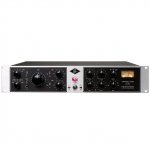I have to disagree with this emphatically. Of course every situation is different. But if we're talking "In general", I'd put EQ before comression 9 out of 10 times. One's going to screw with the other either way. but I'd rather have a relatively balanced signal going into a compressor, as opposed to having the compressor compressing frequencies you want to cut anyway.
Having said that, there might not be any need for one or both of these things. So a discussion on any standard chain is pretty much useless.
yea.... most channel strips have it backwards. affordable voice channels from art, presonus, and so many ohters put the eq after the comp. I disagree with that concept overall. but either way putting a HPF before the comp is vital so the comp doesn't behave erratically with rumble or wind or consonants and so on.
eq at the end TOO if desired, but the comp will behave better if any LF energy you want removed have been removed BEFORE compression, not after. it makes for a more neutral and transparent compression effect (less pumping or other artifacts).
by the way, just read the SOS post. it's true, for tonal shaping eq after is a stronger audible effect, and eq before will alter how compression happens, but his logic is flawed.
he says "let's say you get a great sound with pre and compression then add an eq before the compressor". why the hell would you do that?
you get your tone sequentially one step in a row at a time. pre first. HPF right in there too. THEN wahtever is next, eq in this case, NOT the compressor. THEN compress to taste. then eq AGIAN if you want to since eq post is different from eq pre comp.
why would you ruin your sound by changing something BEFORE one of the units you have already setup perfectly in your serial chain?
silly SOS guy

but he is on target that eq pre alters the operation of the compressor. so it's ideally not best to ALTER yoru pre-compression eq settings after you've set your compressor unless you're prepared to set your compressor all over again by ear as you normally would.
note to inexperienced users: to set a compressor properly you have to slowly dial it in from no effect to audible effect. you can't just set it a certain way and expect magic. just mentioning this so my previous points make sense.
cheers




